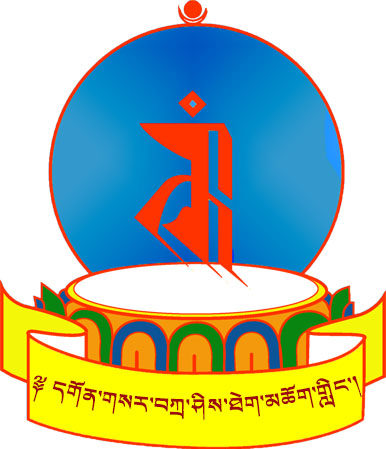Central doctrines of Tibetan Buddhism
The Four Noble Truths
Like all Buddhists, the schools of Tibetan Buddhism uphold the doctrine of the Four Noble Truths. It constitutes the heart of the Buddha’s first public sermon, given in the Deer Park in Sarnath, India more than 2,500 years ago. The Noble Truths are (1) the truth of suffering, (2) the truth of the origin of suffering, (3) the truth of the cessation of suffering, and (4) the truth of the path that leads to the cessation of suffering. The first Truth means that any form of conditioned existence is ultimately the nature of suffering and dissatisfaction. The second Truth means that suffering, which we all instinctively shun, comes about due to conditions, namely the afflictions that lie within us, and the karmic actions which impel us. This state of suffering and delusion is often illustrated by means of the so-called Wheel of Life that depicts the interlocking chains of the ‘twelve links of dependent origination.’ The third Truth means that there is the possibility of the elimination of all our suffering. Lastly, the fourth Truth presents the true path, or the way that will lead to the attainment of this freedom from suffering.
These teachings on the four noble truths are often illustrated through a metaphor of healing. In order for the patient to overcome his or her illness, first a correct diagnosis must be made of the patient’s condition. Second, the physician should examine the conditions that gave rise to the illness and continue to sustain it. Once this examination is done correctly, the physician will be in a position to assess the chance the patient has of overcoming his or her ailment. Then the physician will be able to prescribe the most appropriate regimen for the patient so that he or she will be able to achieve the wellness they seek. The teaching of the Four Noble Truths encapsulates the essence of the teachings of the Buddha.
Emptiness and Dependent Origination
The philosophical view of all four Schools of Tibetan Buddhism is the Mahayana doctrine of emptiness. In this view, all things and events are said to be devoid of any intrinsic and absolute existence. They merely come into being due to the aggregation of multiple causes and conditions. Not only is their material existence dependent upon other factors, but even their very identity is dependent upon other factors such as language, thought and concepts. These together make up worldly convention. This absence of intrinsic existence and intrinsic identity is what is meant by emptiness, and is considered to be the ultimate truth of all things and events. Among the profound implications of this theory of emptiness is that it suggests that all things and events come into being only through a process of dependent origination. They are dependent upon other factors and this fundamental truth about the nature of reality is best explained through a language of interdependence and interrelationship.
Tibetan Buddhist thinkers see this theory of emptiness as an elaboration and refinement of the basic Buddhist theory of no-self (Sanskrit anatman), which lies at the heart of the Buddha’s teaching of the four noble truths. The theory of emptiness was systematically developed as a philosophical standpoint by the well-known Indian Buddhist master Nagarjuna (circa 2nd century CE). His writings, especially the Fundamentals of the Middle Way, led to the evolution of the highly influential Indian Buddhist school called the Middle Way (Madhyamaka). All four principal schools of Tibetan Buddhism perceive themselves to be proponents of the Middle Way philosophy.
The Altruistic Ideal
Together with the cultivation of a profound philosophical insight into emptiness, the development of an altruistic motivation lies at the heart of Tibetan Buddhism. This principle is known as the “Bodhisattva ideal” and refers to a self-less motivation born of great compassion towards all things living. “Great compassion” means the spontaneous wish to see all others free of suffering simply because they are suffering creatures. It is universal, non-discriminatory, and passionate, the individual dedicating his or her entire being to the benefit of other sentient beings. Such noble beings are called Bodhisattvas, individuals with heroic aspirations. Their commitment to relieve others from their sufferings is such that they continually appear in the world in different manifestations to fulfill their noble aspiration.
This Bodhisattva ideal permeates the entire spectrum of Tibetan Buddhist thought and practice, even including the origin myths of the Tibetan people. For example, the Tibetan people believe that they have a special karmic bond with Avalokiteshvara, the Buddha of compassion. He is believed to manifest in different forms, such as the Dalai Lamas, and continues to serve the needs and spiritual aspirations of the Tibetan people. This myth of the Buddha of compassion is also portrayed in powerful images of Tibetan iconography, a most famous example being the image of the thousand-armed Avalokiteshvara. The mantra of the Buddha of compassion, OM MANI PADME HUM, may be found on the lips of all Tibetan Buddhists.
The altruistic Bodhisattva ideal is acted out as the perfection of six practices. They are the perfections of (1) generosity, (2) ethical discipline, (3) forbearance, (4) joyous effort, (5) concentration, and (6) wisdom. Through the pursuit of the perfection of these six practices the Bodhisattva fulfils his or her aspiration to bring about the welfare of all sentient beings. Of the many Indian Buddhist works of Mahayana Buddhism, Nagarjuna’s Precious Garland and Shantideva’s Guide to the Bodhisattva’s Way of Life remain, to this day, the most influential texts for Tibetan Buddhists on the practice of the altruistic ideal of universal compassion. For example, the present Dalai Lama repeatedly states that the following verse from Shantideva is his greatest source of inspiration:
For as long as space endures,
For as long as sentient beings remain,
May I too abide, and
Dispel the miseries of beings.
